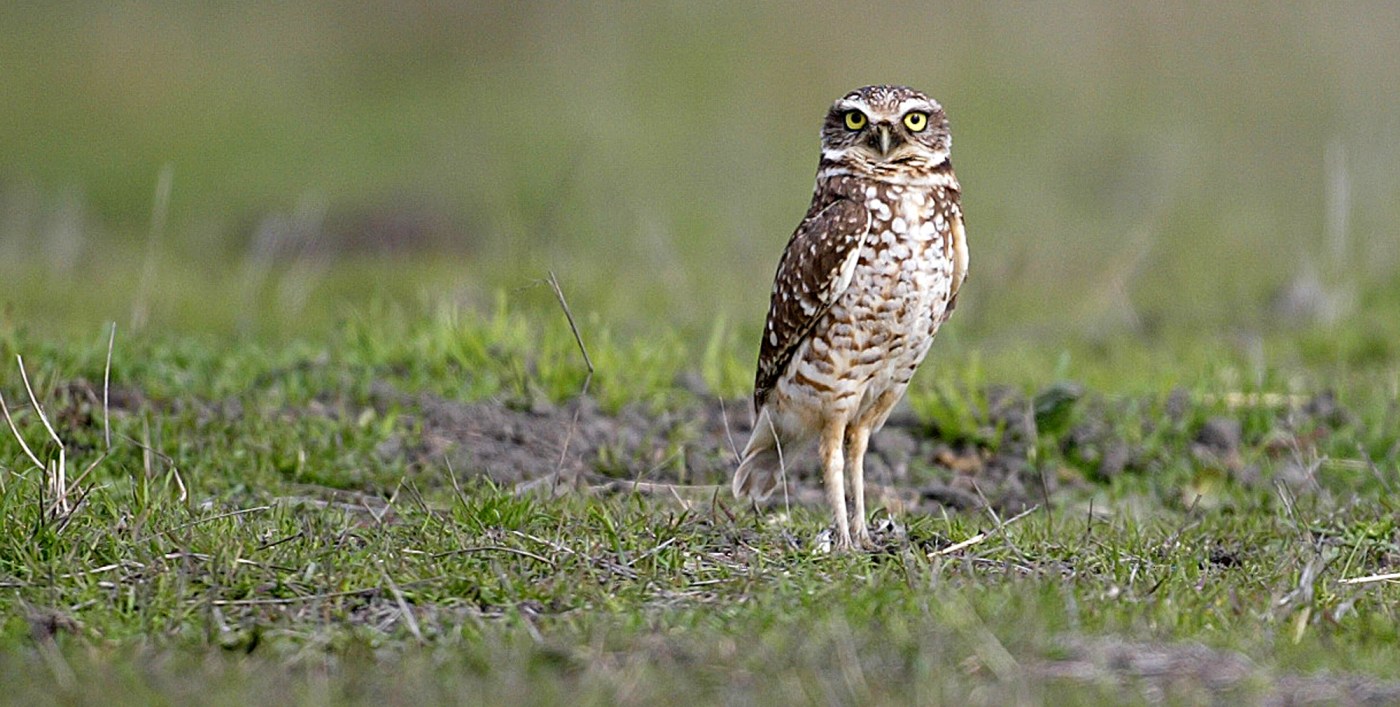
Rare Bay Area owls earn temporary legal protection
A petite Western burrowing owl is no match for a big bulldozer.
In a major step toward protecting the unique ground-dweller from loss of habitat around the San Francisco Bay and four other regions, the California Fish and Game Commission recently voted to make the owl a candidate for protection under the state Endangered Species Act.
That temporarily affords the owl the same protections as a state-listed endangered or threatened species and requires state and local agencies to manage threats, such as ending the state policy of allowing the increasingly rare owl’s removal from land slated for urban development. It could also require more robust mitigation for habitat loss.
“No one can kill or harm them, and developers will need a permit from the Department of Fish and Wildlife” to move forward with the project, said Jeff Miller, senior conservation advocate with the Oakland-based office of the Center for Biological Diversity, who wrote the petition to protect the species.
The Santa Clara Valley Bird Alliance celebrated the news. “We are relieved that the burrowing owl is now recommended as a potential candidate for special status listing, but it breaks our hearts that we had to reach this critical point,” said Shani Kleinhaus, an environmental advocate with the group.
The San Francisco Bay Area, historically one of four primary burrowing owl nesting areas in California, has experienced steep population declines during the last 30 years.
Originally a common resident of the native grasslands on alluvial plains and sinks, owl numbers have plummeted in the last 150 years because of habitat loss, according to professor Lynne Trulio of San Jose State University’s Department of Environmental Studies, who wrote about it in the Breeding Bird Atlas of Santa Clara County.
The owls nest in burrows excavated by California ground squirrels, occasionally popping up to stare with striking yellow eyes. Their fluffy round bodies sit atop long, skinny legs, creating a comical appearance. Unlike other owls, they are not nocturnal and can be spotted during the day.
With the reduction of native grasslands, burrowing owls now live on fields, airports, golf courses and other open short grasslands. In Santa Clara County, for instance, breeding birds are found in a triangle defined by Highway 101, Interstate 880 and the San Francisco Bay.
But even in these places, they’re not safe. Feral cats prey on them at their most vulnerable moments — sitting on their eggs or caring for their chicks. This is a particular problem in fields on the western edge of the San Francisco Bay, such as Mountain View’s North Bayshore, where residents feed feral cats.
Only 21 burrowing owl pairs nested successfully in the South Bay Area in 2023, according to the bird alliance. Almost all of the breeding birds were supported by the Valley Habitat Agency, which built artificial burrows, removed invasive weeds and planted native species to provide food and shelter.
Owls can be seen in the East Bay, as well, but they’re migratory and do not breed. They spend a few autumn and winter months in East Shore State Park, Cesar Chavez Park and the Tom Bates Sports Complex in Berkeley, at Martin Luther King, Jr. Shoreline Park in Alameda, and a few other locations.
A burrowing owl peeks out in an area where animals are reclaiming the land once leveled to make way for new homes in Antioch, Calif., on Tuesday, Oct. 27, 2009. (Sherry LaVars/Staff Archives)
A formerly large population in the Altamont Pass area in eastern Alameda and Contra Costa counties is down to a few hundred pairs and declining rapidly, according to conservation groups.
Burrowing owl numbers are also declining in the Central Valley due to exurban development, conversion of grasslands to agricultural lands, development of large-scale wind and solar energy infrastructure and the eradication of ground squirrels. Additional owls are lost to rodenticides and collisions with wind turbines and cars.
The state’s strongholds for the species are the Imperial Valley, which has an estimated 4,000 breeding pairs, and the southern Central Valley, with around 1,000 pairs.
This month’s vote comes after more than 20 years of effort by conservation groups. The first petition to list the western burrowing owls as an endangered or threatened species was defeated in 2003 after opponents argued that the birds in population strongholds would fill the depleted areas.
But research proved this theory wrong. The birds don’t simply relocate. Empty areas stay empty.
The new petition, submitted in March, was accepted at the commission’s Oct. 10 meeting in Sacramento. Its supporters include the Center for Biological Diversity, Defenders of Wildlife, Burrowing Owl Preservation Society, Santa Clara Valley Audubon Society, Urban Bird Foundation, Central Valley Bird Club and San Bernardino Valley Audubon Society.
Some homebuilders have said adding animals to the endangered list and other regulations pose challenges for the production of new housing.
Clark Morrison, a lawyer for the California Building Industry Association, told the Los Angeles Times, “They slow projects down. In many cases, projects are abandoned because the regulatory challenges can’t be met.”
Related Articles
Panda Cam: Must-see viewing returns with the antics of Yun Chuan and Xin Bao
Rare burrowing owl named as candidate for California’s endangered species list
Behind the scenes at the Monterey Bay Aquarium
The beloved banana slug becomes California’s official state slug
Dad duty: Same-sex flamingo couple hatches egg, cares for chick at California zoo
The next step is a one-year review of the species’ status by the California Department of Fish and Wildlife. After the review is complete, the commission will vote on listing the owls as endangered — the highest level of protection — or threatened, a step down.
The commission could protect the entire statewide range of the species. Or it could decide that only certain populations, such as owls in the Bay Area, warrant protection. It could also opt to do nothing at all.
Meanwhile, conservation groups are working to stop the practice of allowing owls to be evicted from nests. Under state policy, developers can collapse the burrows once the owls have left the nest after breeding season. But the birds return to nests, so lost nests shrink their breeding potential.
“We urgently need legal protections to give these distinctive owls a fighting chance for survival,” said Pamela Flick, California program director with Defenders of Wildlife, “especially since the existing policy framework has failed to adequately safeguard this species for decades.”
Steve Scauzillo of the Southern California News Group contributed to this article.


